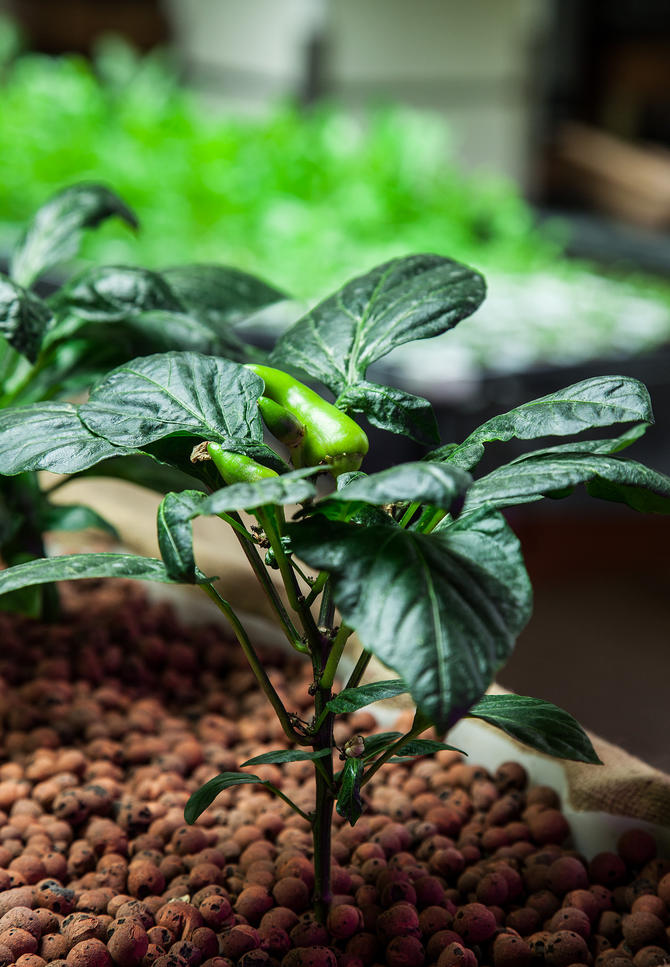It’s a sunny day in February, and I’m standing at the entrance of an enormous brick building in Chicago’s Back of the Yards neighborhood. This area on the city’s Southwest Side became infamous last century after Upton Sinclair described the appalling work conditions at its stockyards in The Jungle. Until it ceased processing pig carcasses in 2007, the 93,000-square-foot space before me served as a Peer Foods meatpacking plant for nearly a century. Now, the building is known simply as The Plant.
Today the facility serves as an incubator for various food start-ups—an ongoing experiment to see whether companies operating under one roof can make one another more sustainable. The mastermind behind the project is John Edel, the founder of Bubbly Dynamics, an organization that renovates and re-uses derelict buildings in Chicago. Edel purchased the place—which a real estate agent called a “strip and rip”—in 2010 for a mere $525,000. He wanted to create a model for urban agriculture in which one business’ trash could serve as another’s treasure, as a means for conserving resources and energy. The ultimate goal, for the building and everything in it, is to consume zero energy.
I sign in for a tour at the shop, where samples of what’s grown, brewed, and baked on the premises are sold. I see fingerlike reishi mushrooms sprouting from a plastic bag within a glass case. Next to them, pearl oyster mushrooms spill from a mixture of sawdust and coffee grounds. The case, it turns out, is a former grocery freezer that’s been re-wired to provide heat and humidity for fungi samples from Fruiting Mushrooms, one of the 16 on-site businesses. Other companies include a kombucha brewery, an indoor microgreens producer, an outdoor vegetable farm, and until recently, an aquaculture operation.

“We’re closing waste loops with all these different businesses within The Plant,” explains tour guide Kassie Hinrichsen.
The building, once considered useless, is a natural fit for food production, Edel says. It has easy-to-clean brick floors, drains in every room, and good insulation, and it is strewn with salvageable materials like the wood rails formerly used for hauling dead pigs. What’s more, The Plant’s unique past gives patrons a sense of place. “There’s a lot of collective community memory,” says Edel as he describes how former Peer Foods employees will come by and ask if they can help renovate their old workspace. The Plant opened for business in 2010, but construction is ongoing, with volunteers and a handful of contractors pitching in on the industrial makeover. As we move through the structure, we see a man fashioning bathrooms from stainless steel reclaimed from a Peer Foods smoker. “Smells like bacon,” someone says.
Once fully operational, The Plant will house some 24 businesses, including a brewery expected to open in the next month or so. But even though it’s only two-thirds full, the results seem promising. Nick Greens, the resident Southsider who started the microgreens company (aptly named Nick Greens) in The Plant, uses leftover burlap sacks from another tenant, 4 Letter Word Coffee, to grow his plants on. Yeast and grains from Whiner Beer, the incoming brewery, will head to Pleasant House Bakery, which will turn them into bread.
The smell of freshly baked loaves is one highlight of the tour; the anaerobic digester is another. Sitting outside the building, the massive apparatus comprises a metal cylinder the size of an oil tanker and a waist-high pool about 50 feet across (filled at the moment with just mud and water). When all is said and done, this contraption will convert the 27 tons of food waste collected daily from on-site businesses and from food producers all over the city into methane gas, which will power and help heat the building.
And other Plants may sprout soon. “It’s intended to be a replicable model,” explains Edel, who often fields calls from other businesses asking for advice on how to use an anaerobic digester to power a building or what it takes to install an aquaponics farm.
At the end of my tour, I wind up back at the shop, where I pour myself a $3 cup of ginger kombucha from the tap and take a sip. I taste a hint of bacon, but it’s probably just my imagination.

This story originally appeared on Earthwire as “What’s Growing on at The Plant?” and is re-published here under a Creative Commons license.





